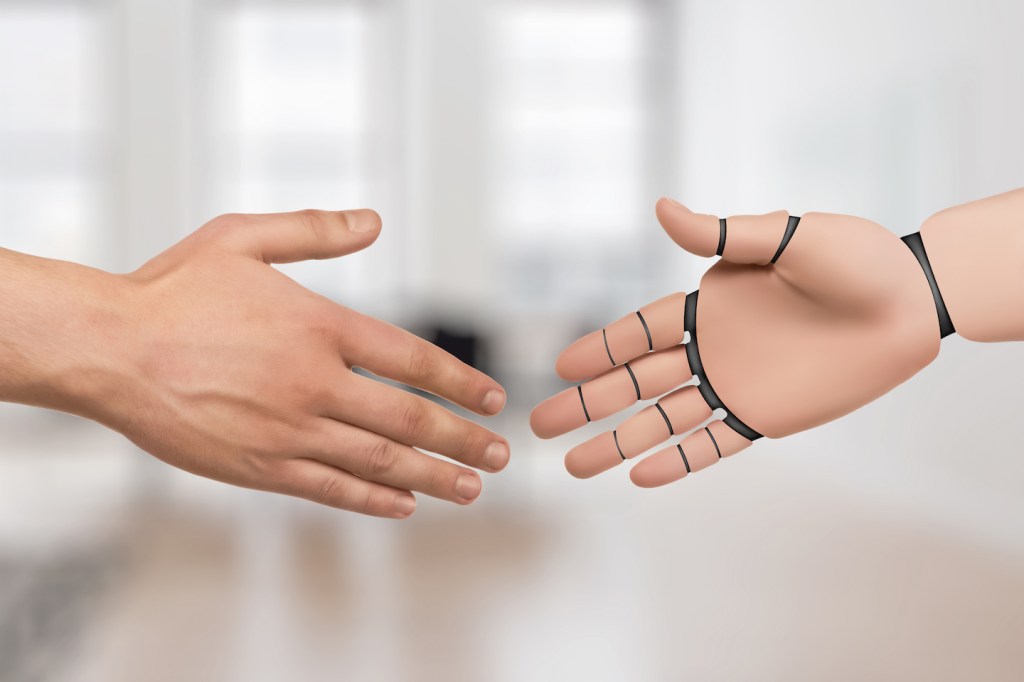Researchers have developed a world-first smart foam technology that could function as the equivalent of human skin for robots – allowing them to sense and “feel” nearby objects, and repairing itself when damaged.
Dubbed AiFoam by developers at the National University of Singapore, the so-called “e-skin” is made of a highly elastic, spongy polymer material that is able to fuse easily into one piece after being cut, mimicking the self-healing abilities of the human epidermis.
Videos by VICE
It is also able to replicate the human sense of touch using microscopic metal particles and tiny electrodes that are embedded into the foam, allowing it to measure electrical properties of materials it comes near to and changing its own electrical properties when it makes contact.
These changes are detected by electrodes, which act as “nerves,” sending signals to a computer and allowing the robot to react according to both the amount and direction of force that is being applied.
As researchers noted, in a paper published late last year in the journal Nature Communications, “the AiFoam e-skin can detect both tactile contact and proximity of the human touch.”
Lead researcher Benjamin Tee told Reuters it is the first material of its kind to combine proximity and pressure sensing with self-healing properties – qualities that the developers believe could make for “smarter human–machine interactions in emerging augmented reality and robotic skin applications.”
“Robotic technologies require sensor skins to become intelligent enough to work well with humans,” Tee told VICE World News via email on Wednesday. “It could mean that robots can be more collaborative, and easier to interact in different types of surroundings without much programming effort.”
Such an idea may feel eerily dystopian; the image of a robot clothed in “skin” that can touch, feel and respond to physical sensations inspires inevitable comparisons to the cinematic cyborgs of Blade Runner and Westworld. As it turns out, that’s not entirely by accident. When asked, Tee himself confirmed that the idea for AiFoam was literally taken straight out of science fiction.
“I was inspired by Star Wars technology, where robots can perform surgery and prosthetic hands have skins,” he told VICE World News. “Specifically, the scene where Luke Skywalker lost his hand in an epic fight inspired this. I thought, if human skin can self-repair, can we do the same for electronic skins that [a] robot uses?”
“Imagine if robots can sense humans even before we touch them – could this make them smarter?”
The team from the National University of Singapore wants AiFoam to be put to practical use within five years, with Tee noting that they “hope to apply it to smarter prosthetic devices that will give users better control of their artificial limbs.”
But while their smart foam technology may signal a breakthrough in the field of robotics, they aren’t the first to try to develop an “e-skin” that performs the same sensory functions as human flesh.
Last year, researchers from Australia’s Royal Melbourne Institute of Technology (RMIT) succeeded in developing an artificial skin that responds to painful stimuli in the same way as real skin – a technology that they suggested could pave the way to better prosthetics, smarter robotics and non-invasive alternatives to skin grafts.
“We’re sensing things all the time through the skin but our pain response only kicks in at a certain point, like when we touch something too hot or too sharp. No electronic technologies have been able to realistically mimic that very human feeling of pain – until now,” lead researcher Professor Madhu Bhaskaran announced in a press release.
The Australian researchers’ artificial skin reacts instantly when pressure, heat or cold reach a painful threshold – a feature that they celebrated as “a critical step forward in the future development of the sophisticated feedback systems that we need to deliver truly smart prosthetics and intelligent robotics.”
Follow Gavin on Twitter
More
From VICE
-

-

Photo: Catherine Falls Commercial / Getty Images -

Photo: Olga Rolenko / Getty Images -

Photo: Rawpixel / Getty Images




